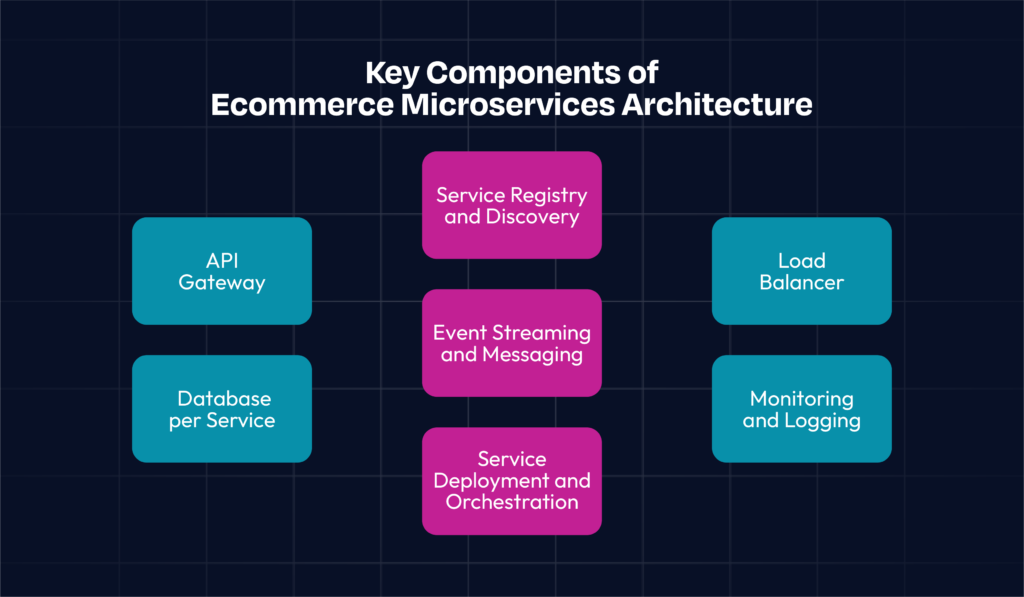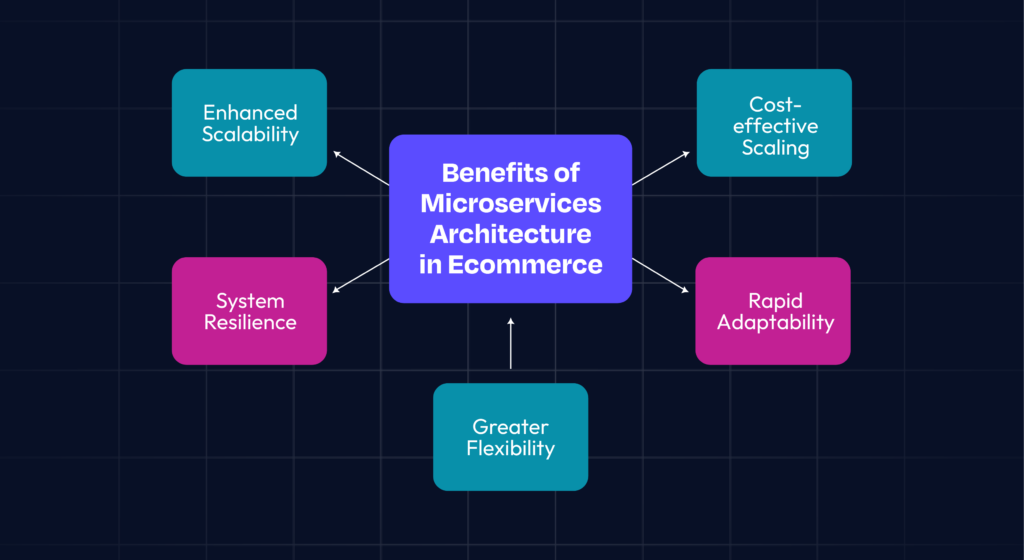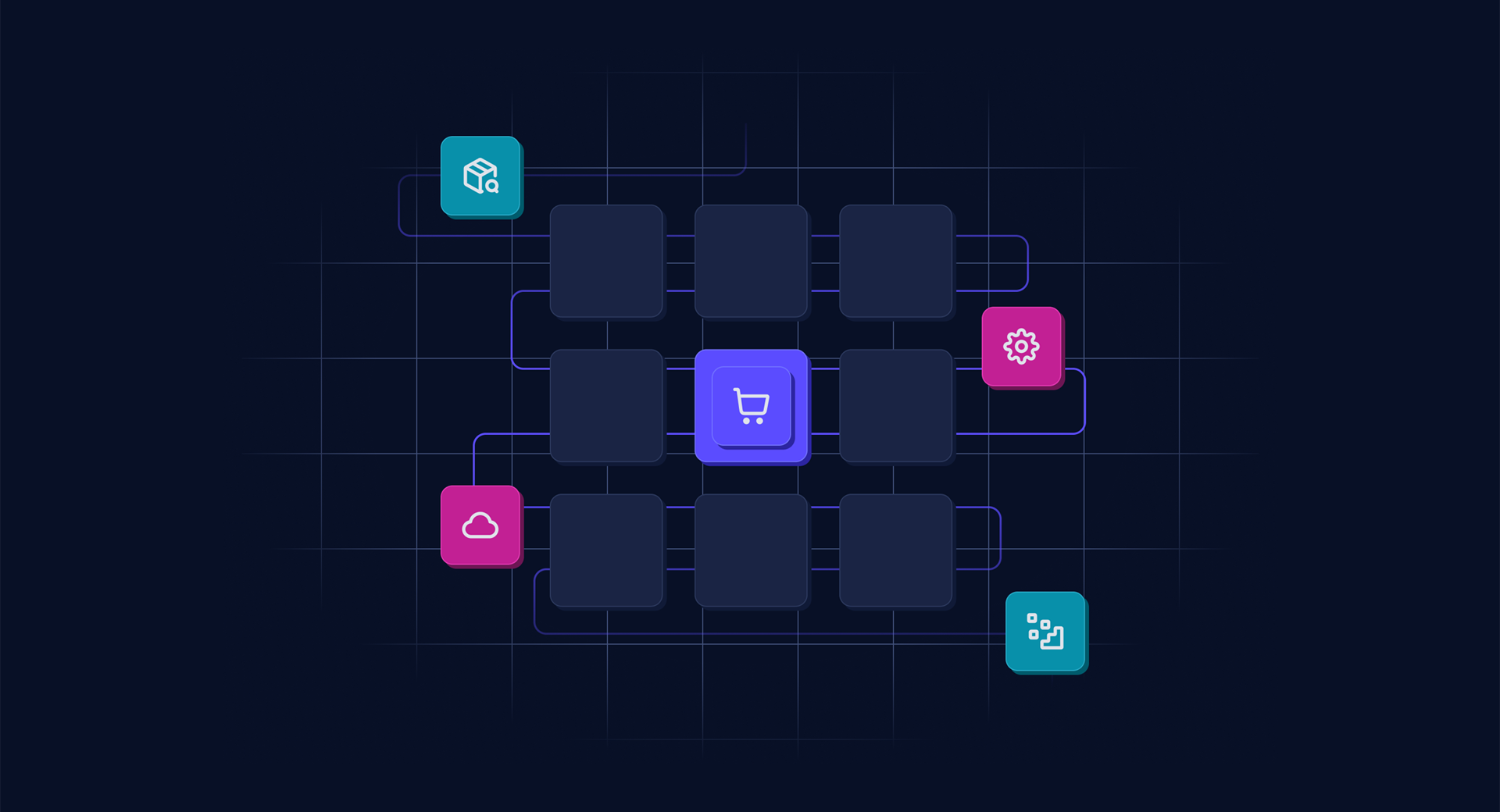Key Highlights
- Ecommerce microservices architecture offers scalability and flexibility to meet market demands.
- It allows for the seamless integration and interaction of different components within an ecommerce platform.
- Adoption of microservices streamlines development and deployment processes, leading to faster time-to-market.
- Real-world success stories showcase how ecommerce giants have leveraged microservices for better business outcomes.
- Overcoming challenges in ecommerce microservices architecture adoption involves identifying common pitfalls and implementing best practices for smooth integration.
- Microservice architecture is utilized in ecommerce for control over specific features, rapid enhancements, and handling high traffic and data volume efficiently.
Monolithic systems struggle to meet the growing demands and frequent updates required by modern ecommerce platforms. As businesses scale, traditional approaches to building ecommerce marketplaces become bottlenecks, slowing development cycles and hindering agility.
To address these challenges, ecommerce microservice architecture has emerged as a dynamic solution, enabling ecommerce development services or companies to build applications that are faster updates, greater scalability, and a seamless customer experience.
Moreover, the microservice market is projected to reach $13.20 billion by 2034, compounding annual growth rate of 21.20% from 2024 to 2034.
In this blog, we’ll explore the fundamentals of ecommerce microservices architecture, the possible benefits as well as challenges of adopting such architecture in ecommerce.
What is Ecommerce Microservice Architecture?
Ecommerce microservice architecture is an autonomous software component designed to perform distinct functions within a broader ecommerce ecosystem. It is a revolutionary shift from traditional monolithic systems that can significantly accelerate development cycles.
While all components in monolithic architectures are tightly connected in a single codebase, making it hard to scale or update one part without affecting the whole system. Microservices architecture solves this by breaking an ecommerce platform into smaller, independent services.
For instance, you own an online store that has features such as product catalogs, processing orders, handling payments, and maintaining customer relationships.
Microservice design pattern allows flexibility to developers to optimize each component without disrupting the entire platform.
Hence, leveraging the ecommerce microservice architecture enhances scalability, efficiency, and agility of ecommerce platforms, delivering exceptional customer experiences and meeting effortlessly to future demands.

Key Components of Ecommerce Microservices Architecture
To understand how service oriented architecture works in ecommerce, you need to first know about their parts and how they connect.
Now, let’s look at the key components of the ecommerce microservice architecture.
1. API Gateway in Ecommerce Microservices Architecture
API gateway acts as the single entry point for all client requests to the eCommerce platform.
In an ecommerce microservices setup, the API Gateway routes requests to the right services, like product catalogs or payment processing, while managing authentication, validation, and response aggregation.
Benefits: Centralizes traffic management, enhances security, and improves performance through caching and rate limiting.
2. Service Registry and Discovery
Microservice deployment strategy enables services to find and communicate with each other dynamically.
Each microservice in an ecommerce platform registers itself in the service registry upon deployment.
For instance, when one service (e.g., an order processing service) needs to interact with another (e.g., an inventory service), it queries the registry to locate it.
Benefits: Facilitates scaling, ensures high availability, and supports load balancing in dynamic environments.
3. Load Balancer in Ecommerce Microservices Architecture
A load balancer works as a performance monitoring microservice, distributing incoming requests evenly across multiple instances of a service.
For an ecommerce platform, high traffic during peak times (e.g., sales events) can overwhelm individual services. A load balancer ensures that requests are distributed across service replicas, maintaining performance and preventing downtime.
Benefits: Enhances fault tolerance, optimizes resource use, and ensures consistent user experience.
4. Database per Service
Each microservice has its own database tailored to its function.
Instead of a single shared database, microservices like product catalogs, order processing, and payments maintain independent databases.
This isolation prevents one service’s data or performance issues from affecting others, allowing a data-driven ecommerce architecture.
Benefits: Improves data scalability, ensures better performance, and supports diverse storage needs.
5. Event Streaming and Messaging in Ecommerce Microservices Architecture
Event streaming ensures seamless communication between microservices using asynchronous messages.
Actions like placing an order or updating inventory often trigger subsequent processes in an ecommerce platform. Tools like Kafka, RabbitMQ, or AWS SQS enable event-driven interactions between services.
When a customer’s order is placed, an event message is sent to update inventory, trigger payment processing, and notify shipping.
Benefits: Decouples services, supports real-time updates, and ensures reliable data exchange.
6. Monitoring and Logging
Microservice architecture tracks system health and identifies issues across microservices.
Monitoring service performance and maintaining logs are crucial in distributed architectures to quickly identify and resolve issues, such as high latency in payment services. Tools like Prometheus and Grafana offer real-time metrics, while ELK (Elasticsearch, Logstash, Kibana) enables efficient log analysis and visualization for effective debugging.
Benefits: Improves system reliability, simplifies troubleshooting, and supports proactive maintenance.
7. Service Deployment and Orchestration
Microservice architecture automates the deployment and management of services.
Platforms like Kubernetes and Docker Swarm manage containers for microservices, ensuring scalability and fault tolerance.
For instance, during a flash sale, orchestration tools can automatically scale up instances of the order processing service to handle demand.
Benefits: Ensures consistent deployments, optimizes resource use, and allows seamless scaling.
The true strength of microservices is in how they work together while staying independent, while communicating through APIs. Thus, the above components allows microservices interact within an ecommerce platform.

Benefits of Microservices Architecture in Ecommerce
Microservice architecture is gaining popularity in ecommerce businesses by addressing the limitations of traditional monolithic systems.
In a scenario where different teams work simultaneously on separate features, such as a loyalty program or a new payment system, a monolithic system would struggle to support this approach.
However, transitioning to a microservice architecture allows these updates to be deployed independently, without disrupting other parts of the system. This significantly accelerates both development and deployment timelines.
Here’s a detailed breakdown of its key advantages:
1. Enhanced Scalability
Microservices enable targeted scaling of specific components to handle high traffic and data volumes effectively.
If your business is facing website crashes during sales or promotions, adopting a microservice architecture can help prevent this by allowing you to scale individual services as needed, ensuring smooth performance even during high traffic periods.
2. System Resilience
Microservices ensure that issues in one service do not disrupt the entire platform.
If the payment service encounters an error, microservice architecture ensures that the product catalog and order management remain unaffected.
Therefore, transitioning to this modular approach enhances reliability, ensures high uptime, and reduces the impact of failures on customer experience.
3. Greater Flexibility
Each microservice can utilize the best tools and technologies suited for its specific function.
For example, a product catalog might use a NoSQL database for faster searches, while a relational database ensures transactional integrity in the payment service.
This encourages innovation, improves efficiency, and allows businesses to adopt advanced solutions easily.
4. Rapid Adaptability
Microservices simplify the addition of new features to meet evolving customer demands and support continuous improvement.
Suppose you want to introduce a “buy now, pay later” feature. Ecommerce application development with microservices allows development and integration of such experimentation independently without disrupting other services.
Hence, it keeps businesses agile, enhances customer satisfaction, and keeps businesses competitive.
5. Cost-Effective Scaling
By scaling only the services experiencing high demand, businesses can save resources.
During a sale, you can scale the order management service instead of the entire platform reducing operational costs.
It optimizes resource use, minimizes costs, and improves profitability.

Challenges in Implementing Microservices in Ecommerce
The benefits of microservices are clear. However, switching to this method comes with some challenges. It is important to see what these challenges are and find good solutions to handle them.
Let’s look at some common challenges of microservice architecture.
- Lack of clear service boundaries: One of the most common pitfalls when adopting microservices is failing to define clear boundaries between services. This can result in tightly coupled services, which undermines the core benefit of microservices-independence.
- Lack of fault isolation: In a distributed system, a failure in one service can potentially affect others if not properly isolated. Microservices require effective fault isolation to maintain system stability.
- Complexity in service management: Managing multiple microservices introduces complexity in deployment, monitoring, and scaling. Without proper oversight, it can become overwhelming to track all services.
- Data management and consistency: Each microservice typically has its own database, which can lead to challenges in maintaining data consistency and integrity across services.
- Communication overhead: Increased interactions between microservices can lead to communication overhead, resulting in latency and performance bottlenecks.
Best Practices for Ecommerce Microservice Architecture
Implementing microservice architecture can be challenging if not executed properly. You require careful planning and execution to ensure a seamless transition.
To smoothly transition to microservices in ecommerce, start by designing each microservice as an independent unit, making integration easier. Use clear APIs and versioning to avoid breaking changes, and test thoroughly to ensure services work well together.
Having a dedicated DevOps team is essential for managing deployment, monitoring, and integration. It’s also important to define Service-Level Agreements (SLAs) and use Domain-Driven Design (DDD) to clearly separate service boundaries based on business functions.
For effective communication, use asynchronous methods like message queues, and set up an API Gateway to reduce network latency.
Moreover, to prevent service failures, incorporate circuit breakers, fallback plans, and centralized error handling. Also, ensure data integrity with eventual consistency and synchronization tools like Kafka.
Finally, adopt DevOps practices and use tools like Kubernetes to automate deployments, scale services, and reduce human error, making the entire transition smoother and more efficient.
Case Studies of Ecommerce Leveraging Microservices Architecture
E-commerce giants like Amazon, Netflix, eBay, and Gilt have successfully adopted microservices architecture, fueling their growth and success.
These companies manage massive online traffic and require systems that can scale efficiently and stay resilient.
Microservices have enabled them to handle high demands, improve user experiences, and innovate rapidly – key factors in their ongoing success.
Amazon
Amazon previously faced a challenge to scale during high-demand periods like Black Friday or Cyber Monday. This led Amazon to shift from a monolithic system to a microservices architecture, keeping pace with their expanding product catalog and customer base.
With microservices, the company scaled specific services independently, ensuring a smooth shopping experience even during peak traffic times.
This flexible and scalable approach has been crucial in supporting Amazon’s global reach.
Netflix
Netflix, a leader in online streaming, leveraged ecommerce microservices architecture to manage its vast user base and high traffic.
The platform, Netflix can now isolate issues quickly, update systems faster, and improve features with minimal disruption. Their use of service discovery and asynchronous communication ensures smooth operation and meets dynamic market demands.
An API Gateway effectively manages the numerous microservices, providing a consistent data flow and ensuring a seamless, personalized viewing experience for users.
Gilt
Gilt embraced ecommerce microservices architecture by splitting its platform into various microservices, making it easier to scale and adapt.
Each service, such as order management or payment processing, functions independently, allowing for quicker updates and easier integration of new features.
This agility has helped Gilt remain innovative and meet market demands more effectively, giving them a competitive edge in the e-commerce space.
eBay
eBay has adopted microservices to scale and improve its platform. By using different microservices for tasks like payment processing and order management, eBay ensures a smooth and reliable shopping experience for millions of users.
The modular nature of microservices allows eBay to add new features quickly and respond to market changes with flexibility.
Furthermore, the approach helps address challenges like data consistency and fault isolation, ensuring that the platform remains stable even during periods of high traffic.
The Impact of Microservices on E-Commerce Success
For these e-commerce leaders, microservices have been instrumental in driving growth, handling traffic surges, and continuously innovating.
The ability to isolate failures, scale services independently, and rapidly deploy new features has helped them stay competitive in the fast-paced e-commerce industry.
The main reasons for the success of these giants has been adopting microservice architecture. It has transformed how these companies operate, offering improved performance, enhanced user experiences, and the agility needed to thrive in the digital age.
Lessons Learned from Their Migration Journey
The migration journey to microservices architecture is beneficial, but it also has its challenges. Ecommerce businesses can get useful lessons learned from those who have made this change successfully. A key point is to plan carefully and take small steps.
Trying to change your whole system all at once can create problems and interruptions. Instead, begin by finding specific functions that can be separated into their own services. This slow method makes transitions easier, reduces risks, and helps solve problems more effectively.
Another important thing is to build a culture of best practices among the development teams. This means using automation for testing and deployments. It also involves setting up strong monitoring and logging systems. Lastly, clear communication between teams that manage different microservices is essential.
Ready to take the next step?
Transitioning to a microservices architecture is a big step. You should implement it based on your business needs, technical skills, and long-term growth plans.
Start by looking closely at your current architecture. Find spots where microservices can help you. Begin small by breaking down clear functions, then slowly grow your microservices setup.
Keep in mind that adopting microservices is a continuous process. It needs a culture of learning and improving over time. By using the information in this blog post, you can make smart choices for a successful transformation to microservices.
Choosing to use microservices is not just a trend; it’s a smart choice for a more agile and customer-focused ecommerce platform. If you want to improve your ecommerce platform, feel free to reach out for expert help.
Frequently Asked Questions
Microservices offer many benefits for ecommerce. Fault isolation helps keep the entire platform running even if one service has a problem. Their modular architecture makes it easy to update separate independent services without causing issues for others. Also, asynchronous communication through an API gateway improves efficiency and scalability.
Microservices help create a personal and quick customer experience. By separating things like the user interface, shopping cart service, and personalization tools, companies can adjust the customer experience based on what each person likes. This way, they can go beyond customer expectations.
Small businesses can benefit from microservices just like larger companies. They can use these benefits for certain business functions or as part of a step-by-step plan. It’s important to see if the advantages are greater than the difficulties. This decision should take into account their specific needs and the size of their development team.




[…] You might want to check 11 SaaS Success Stories Worldwide with Real-World Examples. […]
[…] Additionally, check out an article on 11 SaaS Success Stories Worldwide with Real-World Examples. […]
[…] are some of the SaaS success stories that highlight the tangible benefits that come from careful planning, selecting the right SaaS […]
[…] options, and personal touches—these are the secret sauce to truthfully happy and loyal customers (Asterdio). Here’s the […]